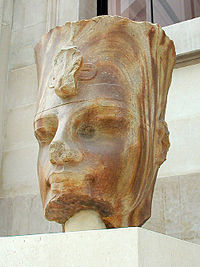- Colossal quartzite statue of Amenhotep III
-
 Colossal quartzite head of Amenhotep III in the British Museum
Colossal quartzite head of Amenhotep III in the British Museum
The 18th Dynasty Ancient Egyptian colossal quartzite statue of Amenhotep III, dating from c.1350 BC, was found in the massive mortuary temple of the pharaoh Amenhotep III on the West Bank of the River Nile at Thebes (the present-day settlement of Kom el-Hitan) in Egypt.[1] Only the head of the broken colossal statue survives. It is part of the British Museum's Department of Ancient Egypt and Sudan collection.
This brown quartzite statue was one of a series of near-identical statues that flanked the west side of a colonnaded courtyard. When complete, it would have measured more than 8 metres (26 feet) high without its base, and the body would have stood in the classic pose of Osiris with legs together and arms crossed, holding the crook and the flail, which were symbols of Egyptian kingship. The statue would have worn a short royal kilt and the red crown of Lower Egypt. The discovery in 1964 of the head of one other statue and numerous body-fragments of yet more has allowed the reconstruction of the statue's pose. The statues on the other side of the courtyard were similar, but were made of red granite and wore the white crown of Upper Egypt.[1][2]
The pose has been interpreted as symbolising the first "sed" festival of Amenhotep III, when it was believed that the pharaoh underwent a rite of rejuvenation and became a god while still living. This happened on the 30th anniversary of his rule. As a god, Amenhotep III was then worshipped through this statue and similar ones.[1]
The head is 1.17m high, 81 cm wide and 66 cm deep. It was purchased from Henry Salt in 1823. It has the reference number EA 7 and is currently displayed in the Museum's Great Court. From September 2006-February 2008 it was sent on loan to the United States of America as part of the "Temples and Tombs" travelling exhibition.[1]
References
Reading
- B. Porter & R. Moss, Topographical Bibliography of Ancient Egyptian Hieroglyphic Texts, Reliefs and Paintings II (Oxford, 1972), p. 453 (with earlier bibliography)
- T. G. H. James & W. V. Davies, Egyptian Sculpture (London, 1983), p. 38, fig.45
- P. Kozloff, B. Bryan and M. Berman, Egypt's Dazzling Sun (Cleveland Museum of Art, 1992), pp. 156–158 = Le Pharaon-Soleil (Paris, 1993), pp. 126–128
- G. Robins, The Art of Ancient Egypt(London, 1997), p. 122, fig.135
- Art and Afterlife in Ancient Egypt (Japan 1999-2000), p. 32
- Temples and Tombs [exhibition catalogue] (American Federation of Arts, 2006) 52, cat no. 10
- P. Nicholson and I. Shaw, Ancient Egyptian Materials and Technology (Cambridge 2000), p. 54
- E.R. Russmann, Eternal Egypt: Masterworks of (University of California Press, 2001)
- N. Strudwick, Masterpieces of Ancient Egypt, London: British Museum Publications, 2006, pp. 154–5
External links
Categories: Ancient Egyptian objects in the British Museum | Sculptures of ancient Egypt | 14th-century BC works | Colossal statues
Wikimedia Foundation. 2010.
